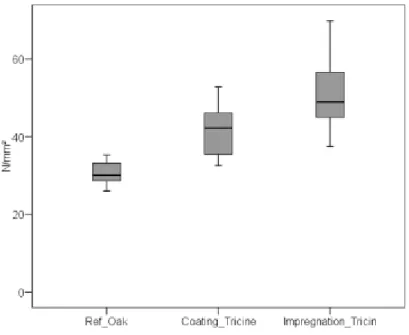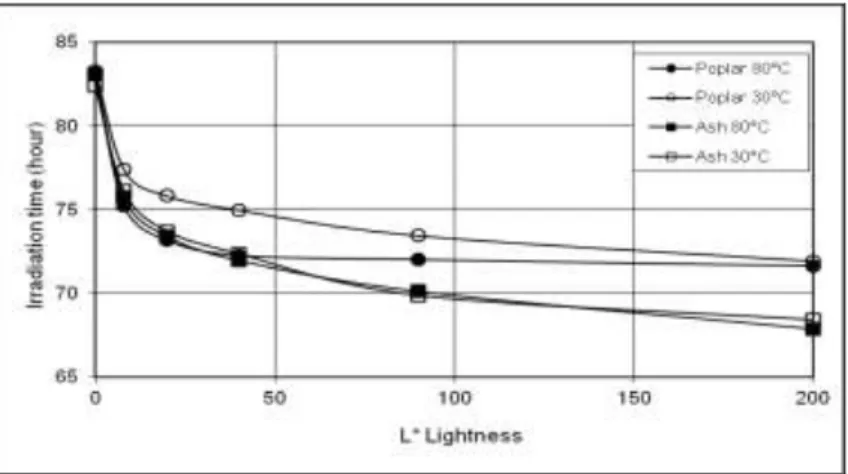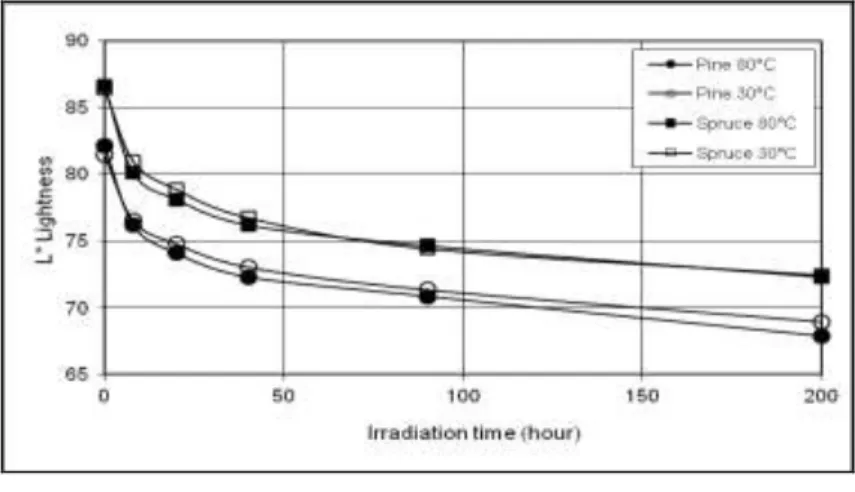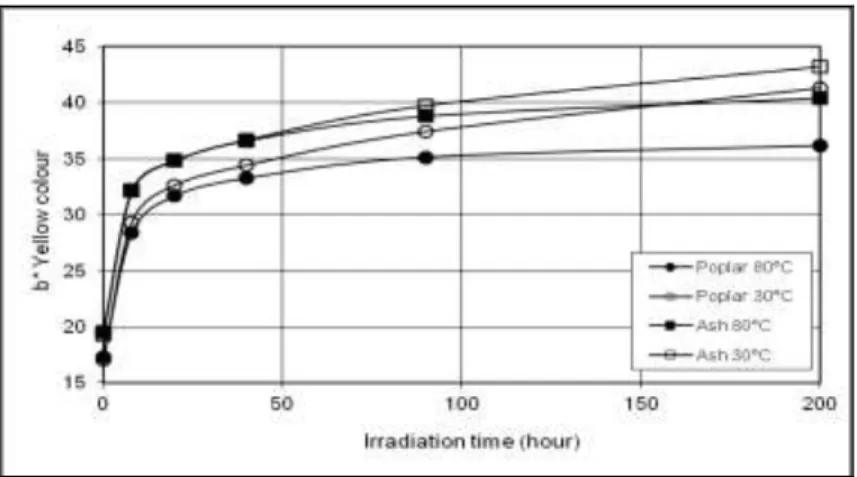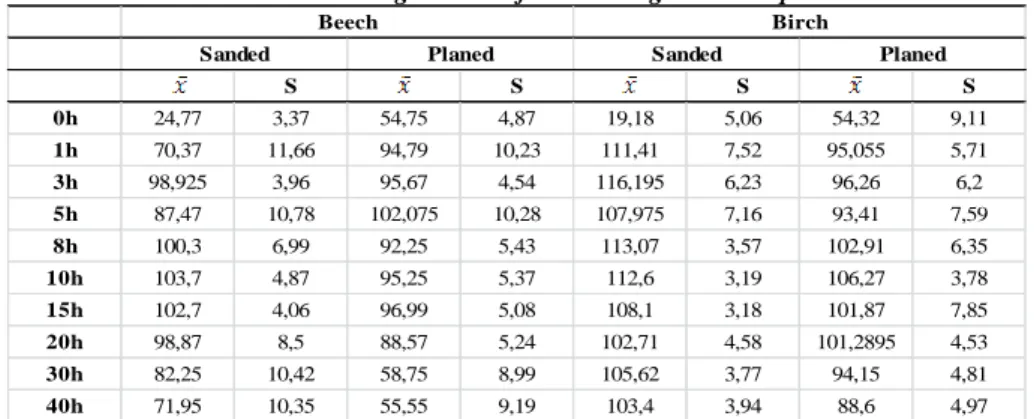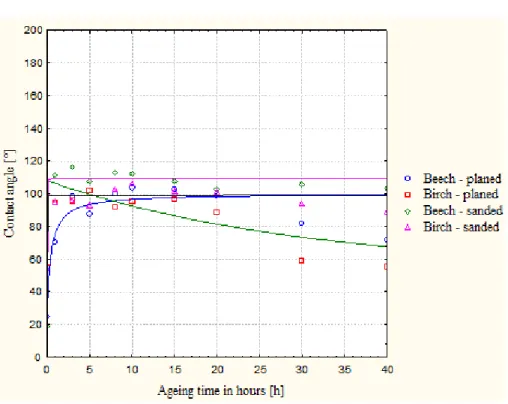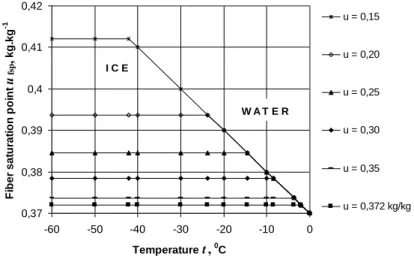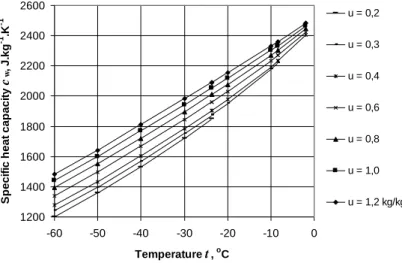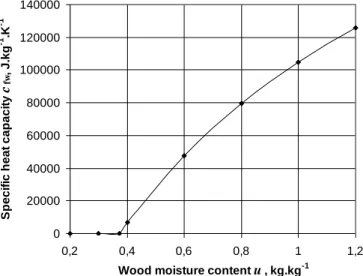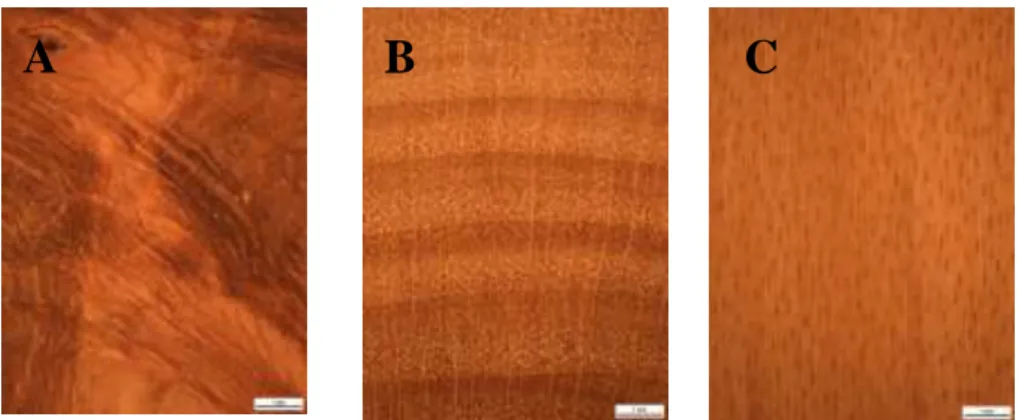Róbert Németh
&
Alfred Teischinger editors
THE 5
THCONFERENCE ON
HARDWOOD RESEARCH AND
UTILISATION IN
EUROPE 2012
Hardwood Research and Utilisation in Europe. Sopron, Hungary, 10-11 September 2012
Scientific Committee
Prof. Dr. Dr. h.c. Marian Babiak Technical University Zvolen Prof. Dr. Dr. h.c. Michael Bariska ETHZ Zürich
Prof. Dr. Dr. h.c. František Hapla Georg-August Universität Göttingen Prof. Dr. Dr. h.c. Peter Niemz ETHZ Zürich
Prof. Dr. Željko Gorišek Prof. Dr. André Wagenfuehr
University of Ljubljana
Technische Universität Dresden Prof. Dr. h.c. Sándor Molnár University of West Hungary Prof. Dr. Marketta Sipi University of Helsinki Prof. Dr. Joris Van Acker Ghent University
Prof. Dr. Maria Cristina Timar Transilvania University of Brasov Dr. Grzegorz Jednoralski Warsaw Agricultural University Prof. Dr. Julia Mihailova University of Forestry-Sofia
Organising Committee
Dr. habil. Róbert Németh University of West Hungary Prof. Dr. Alfred Teischinger
Dr. Christoph Buksnowitz
BOKU University BOKU University
Marie Louise Zukal BOKU University
József Ábrahám University of West Hungary
Miklos Bak University of West Hungary
© Róbert Németh & Alfred Teischinger, editors, 2012
© University of West Hungary Press, Sopron, Hungary Printing: Lővér-Print Nyomdaipari Kft., Sopron, Hungary Technical editors: Péter Szeles & Róbert Németh
The manuscripts have been peer-reviewed by the editors and have not been subjected to linguistic revision.
ISBN 978-963-9883-97-0
New challenge of hardwood utilization
Hardwood is sometimes referred to the pearl of the forests. Hardwood utilization is more complex than softwood processing and there are great challenges for a competitive hardwood process chain. Due to many reasons such as changes in silviculture, changing ecological conditions the share of hardwoods in Europe’s forests is growing and hardwood processing and utilization gains more and more importance. The overall objective of the proposed action is an improvement in competitiveness of European hardwood products by creating a Pan-European network with special emphasis on supporting early stage research.
A competitive and innovative hardwood process chain has to be developed by new allocation concepts to overcome the lack of economical efficiency of the mostly small enterprises with scattered hardwood resources, innovative manufacturing systems, a quality deployment model for specific process chains and concepts for technology transfer between research institutions and hardwood producers / processors has to be installed.
The conference series of hardwood research in Sopron, Hungary, already addressed the various assets and challenges of hardwood such as issues of hardwood research and utilization in Europe (first and second conference), the beauty of hardwood (third conference). Prof. Sándor Molnár and Dr.
László Bejó did that time a pioneering work and established good reputation and scientific background for the conference edition in 2012.
We are delighted to present the proceedings of the 5th European Conference on Science and Technology on Hardwood, held in Sopron, Hungary, 2012, which has been organized in close cooperation with the University of Natural Resources and Applied Life Sciences, BOKU Vienna. This cooperation also reflects some cooperation in hardwood research of the two universities and we hope to present interesting topics of hardwood research and technology in the various sessions the industrial visit as well. We are grateful to all speakers, poster presenters and participants for this information transfer and for making this conference successful. We also hope that the readers of these proceedings will benefit from this documentation.
Alfred Teischinger & Róbert Németh
SESSION I STRUCTURE & PROPERTIES
RELATIONS BETWEEN SELECTED CHEMICAL PROPERTIES AND WOOD DURABILITY AS WELL AS MECHANICAL FEATURES OF THERMALLY MODIFIED WOOD ... 7
TAMÁS HOFMANN,TAMÁS RÉTFALVI,WIBKE UNGER,VERENA KRACKLER,MELANIE WETZIG, PETER NIEMZ
SELECTED PHYSICAL AND MECHANICAL BEHAVIOUR OF SYCAMORE MAPLE (ACER PSEUDOPLATANUS L.) AND EUROPEAN BEECH (FAGUS SYLVATICA L.) ... 17
PETER NIEMZ;TOMASZ OZYHAR AND WALTER SONDEREGGER
SURFACE MODIFICATION OF OAKWOOD WITH TRICINE ... 27 MARKUS HAUPTMANN,STEFANO D’AMICO, CHRISTIAN HANSMANN
SUPERPOSITION OF THERMAL- AND PHOTODEGRADATION FOR WOOD
MONITORED BY COLOUR MEASUREMENT ... 33 LASZLO PERSZE, LASZLO TOLVAJ
FEATURE OF CONTACT ANGLE OF AGEING BEECH AND BIRCH SURFACES ... 41 CSILLA CSIHA,ÉVA A.PAPP,JÓZSEF VALENT, LEVENTE CSÓKA
COMPUTATION OF THE SPECIFIC HEAT CAPACITY OF FROZEN POPLAR WOOD DURING ITS DEFROSTING... 50
NENCHO DELIISKI
COMPARISON OF PHYSICAL PROPERTIES OF HEAT TREATED AND UNTREATED HORNBEAM WOOD, BEECH WOOD, ASH WOOD AND OAK WOOD... 63
TOMISLAV SINKOVIĆ,SLAVKO GOVORČIN,TOMISLAV SEDLAR
PROPERTIES OF TRUNK AND BRIARWOOD OF TREE HEATH (ERICA ARBOREA L.) FROM ISLAND RAB ... 71
SLAVKO GOVORČIN,TOMISLAV SINKOVIĆ,TOMISLAV SEDLAR,BOGOSLAV ŠEFC,IVA IŠTOK ANATOMICAL, MECHANICAL AND PHYSICAL PROPERTIES OF TWO INDIGENOUS HARDWOOD SPECIES GROWN IN SUDAN ... 79
HANADI MOHAMED SHAWGI GAMAL,CLAUS-THOMAS BUES
GERHARD GRÜLL,IGOR SCOTLAND,IRENE SPITALER, MARTIN TEIBINGER VARIATION IN WOOD FIBER CHARACTERISTICS AMONG THIRTY TWO HARDWOOD SPECIES GROWN IN LOW-RAINFALL WOOD LAND SAVANNAH (SUDAN) ... 104
HANADI MOHAMED SHAWGI GAMAL, ABDEL AZIM YASSIN ABDELGADIR,CLAUS-THOMAS BUES DENSIFICATION OF BEECH WOOD: FURFURYL ALCOHOL IMPREGNATION FOR IMPROVED PLASTICIZATION, FIXATION AND PROPERTIES ... 115
TOBIAS DIETRICH,ALEXANDER PFRIEM,BEATE BUCHELT,ANDRÉ WAGENFÜHR
INCREASING THE VALUE OF HARDWOOD VENEERS BY HEATING TREATMENT... 125 SÁNDOR FEHÉR,SZABOLCS KOMÁN,RÓBERT TASCHNER,ZOLTÁN BÖRCSÖK
WOOD MODIFICATION AT THE UNIVERSITY OF WEST HUNGARY ... 135 MIKLÓS BAK,RÓBERT NÉMETH,NORBERT HORVÁTH
SESSION II QUALITY & SORTING
DIAGNOSTIC FEATURES OF EUROPEAN BEECH WITH WAVY-GRAINED WOOD GROWING IN UKRAINIAN CARPATHIAN ... 144
IVAN SOPUSHYNSKYY
QUALITY ASSESSMENT OF BEECH LOGS USING CT-SCANNING TECHNOLOGY ... 149 STEFAN M.STÄNGLE,FRANKA BRÜCHERT,UDO H.SAUTER
ROUGHNESS OF BLACK ALDER WOOD SURFACES AFTER MILLING AND SANDING ... 159
EMILIA-ADELA SALCA,IVAN CISMARU
SUITABILITY OF STRESS WAVE AND ELECTRICAL RESISTIVITY TOMOGRAPHY FOR RING-SHAKE DETECTION IN STANDING SWEET CHESTNUT TREES ... 170
REBECCA HAPPE,STEFFEN RUST,FRANTIŠEK HAPLA
COLOUR CHARACTERIZATION OF VARIOUS HARDWOODS... 180 A.TEISCHINGER,M.L.ZUKAL,T.MEINTS, C.HANSMANN,R.STINGL
MICRODENSITOMETRY OF HARDWOOD USING HELICAL X-RAY TOMOGRAPHY 189 JORIS VAN ACKER,JAN VAN DEN BULCKE,MAAIKE DE RIDDER,AGATHE DIÉ,BENJAMIN TOIRAMBÉ,DRIES VANSTEENKISTE,WANNES HUBAU,DENIS VAN LOO,MANUEL DIERICK,BERT MASSCHAELE,YONI DE WITTE,HANS BEECKMAN,LUC VAN HOOREBEKE
ASPECTS OF BEECH WOOD (FAGUS SYLVATICA) DEGRADATION AFTER 7 YEARS EXPOSURE IN A MODIFIED L-JOINT TEST – A COMPARISON BETWEEN NON- DESTRUCTIVE AND DESTRUCTIVE EVALUATION ... 200
MARIA CRISTINA TIMAR,ANCA VARODI,EMANUELA BELDEAN,OCTAVIA ZELENIUC WATER ABSORPTION, COLOR CHANGES AND PHOTOSTABILITY OF BENZOYLATED BEECH WOOD VENEER ... 215
BEHZAD BAZYAR, ALIREZA AMINZADEH
Relations between selected chemical properties and wood durability as well as mechanical features of
thermally modified wood*
Tamás Hofmann
1, Tamás Rétfalvi
1, Wibke Unger
2, Verena Krackler
3, Melanie Wetzig
3, Peter Niemz
31 4 Bajcsy-Zsilinkszy str., H-9400, Sopron, Hungary, University of West Hungary, Institute of Chemistry, email: hofmannt@emk.nyme.hu, tretfalvi@emk.nyme.hu
2 1 Alfred-Möller str., D-16225, Eberswalde, Germany, University of Applied Sciences Eberswalde, Wood Science and Technology, email: wunger@fh-eberswalde.de
3 6 Schaffmattstrasse, CH-8093, Zürich, Switzerland, ETH Zürich, Institute for Building Materials, Wood Physics, email: niemzp@ethz.ch
Keywords: thermally modified timber, chemical composition, mechanical properties, DPPH assay, wood durability
ABSTRACT
Thermal modification of wood is an environmental friendly process for improving specific wood properties (color, durability, dimensional stability) without the use of additional chemicals. There is a constantly growing market for thermally modified timber, which challenges the industry to introduce faster and reliable methods for quality control and to eliminate some typical problems associated with the products and the technology (decreasing mechanical properties, emissions of volatile organic compounds from the wood, corrosion of technological equipment, waste water utilization).
The recent work focuses on three industrial technologies (with steam atmosphere, with inert gas atmosphere, and vacuum-press dewatering method) where optimization was carried out for the reduction of emissions by varying temperature and duration parameters. Beech, ash and spruce were considered for the research. Results are discussed regarding the changes in the loss of VOCs, pH of the wood extracts as well as the changes in the bending strength and the density of the wood.
---
* This (research) was supported by the European Union and co-financed by the European Social Fund in frame of the project "Talentum - Development of the complex condition framework for nursing talented students at the University of West Hungary", project ID: TÁMOP 4.2.2.B-10/1-2010-0018
The 5th Conference on Hardwood Research and Utilisation in Europe 2012
Regarding wood durability the mass loss was determined according to the EN 113 norm (incubation for 16 weeks). In connection with wood durability the total phenol content and the antioxidant activity of the wood were also measured using a novel, modified DPPH assay which was capable to measure the antioxidant ability of the wood directly instead of measuring the antioxidant level of the wood extracts only. Correlations have been established between durability parameters, total phenol content and antioxidant capacity. For beech and ash samples good correlations have been found between wood durability (mass loss) and DPPH assay values which could open up new possibilities for the estimation of wood durability in the future.
INTRODUCTION
Thermal modification of wood is an environmental friendly process for improving specific wood properties (color, durability, dimensional stability) without the use of additional chemicals. It is usually carried out between 160 and 260 oC in various media (steam, nitrogen gas, vacuum, hot oil) using specific time schedules, depending on wood species and the properties which are to be attained (HILL 2006). There is a constantly growing market for thermally modified timber, which challenges the industry to introduce faster and reliable methods for the quality control of their products, especially in the field of determining wood durability, which has been also one of the main aims of the research recently (MILITZ AND ALTGEN 2011). Besides some decreasing mechanical properties e.g. bending strength and density (WINDEISEN ET AL. 2009) one major problem associated with thermally modified wood is its characteristic smell and the associated health issues.
These emissions are measured as the loss of volatile organic compounds (VOCs), mostly acids, aldehydes and phenolic compounds (ROFFAEL ET AL. 2008, RÉTFALVI ET AL. 2009, WETZIG ET AL.2011) which require process optimization to get rid of without compromising any of the desired features or worsening mechanical properties or increasing production costs significantly.
The recent work focuses on three industrial technologies (with steam atmosphere, with inert gas atmosphere, and vacuum-press dewatering method) where optimization was carried out for the reduction of emissions by varying maximum temperature and duration, varying the maximum temperature and pressure, and varying maximum temperature respectively.
Beech, ash and spruce were considered for the research. Results are discussed regarding the changes in the loss of VOCs (acetic acid, formic
acid, furfural, 5-methyl furfural), pH of the wood extracts as well as the changes in the bending strength and the density of the wood.
Regarding wood durability the mass loss was determined according to the EN 113 norm (incubation for 16 weeks). In connection with wood durability the total phenol content and the antioxidant activity of the wood were also measured. Antioxidant activity was determined using a novel, modified DPPH assay which was capable to measure the antioxidant ability of the wood directly instead of measuring the antioxidant level of the wood extracts only. Correlations have been established between durability parameters, total phenol content and antioxidant capacity. For beech and ash samples good correlations have been found between wood durability (mass loss) and DPPH assay values which could open up new possibilities for the estimation of wood durability in the future.
EXPERIMENTAL METHODS Materials
Beech, ash and spruce were considered for research. All samples originated from industrial production. Table 1 summarizes the original parameters as well as the optimized parameters of the production for each technology. In the case of vacuum-press-dewatering technology only ash and beech was treated. As the samples originated from industrial production the exact parameters of the modification technology are not public.
Table 1: The modification technologies and the parameters Modification technology Original parameters Optimized parameters
N2 gas Unknown Pressure is released from the autoclave after reaching maximum temperature (purging).
Steam Unknown Reducing the maximum temperature while increasing treatment time.
Vacuum-press-dewatering Unknown Increasing maximum temperature from 195 to 210 oC with the same heating program and vacuum.
Loss of VOCs and the pH of the wood extracts
The loss of VOCs was determined according to the flask method (DIN EN 717-3) after incubation for 24 hours at 40 oC. The extracts were filtered and their pH was measured using a potentiometric pH meter. The VOC components of the extracts were separated and quantitated using HPLC (Bio-Rad Aminex HPX-87H column, 50 oC, 0.005M H2SO4 mobile phase at 0.6 ml/min and UV detection at 210 nm). Results were given in mg/g dry wood. One replicated was made from each sample.
The 5th Conference on Hardwood Research and Utilisation in Europe 2012
Total phenol content
100g of wood samples were ground and sieved. The 0.2-0.63 mm fraction was used for further analysis. 0.25 wood was extracted in 6 consecutive steps with 80% aqueous methanol in an ultrasonic bath. In one extraction step 4 ml of solvent was used for 30 minutes. Extracts were collected in a 25 ml volumetric flask and filled up after the final step. Total phenol content was determined using the method of Folin and Ciocaltau (SINGLETON AND
ROSSI 1963) and was given in mmol quercetin/100g dry wood. The measurement was done in 3 replicates.
Modified DPPH assay
DPPH assay was modified so as to measure the antioxidant capacity of the wood directly. 1 mg of wood (0.2-0.63 mm fraction) was measured in a plastic cuvette (1 cm optical path). After that a teflon-covered magnetic stirring bar (0.7 cm) was placed into the cuvette. 2.25 ml methanol was filled into the cuvette and then 0.75 ml 200 M DPPH solution was added. The cuvette was covered and placed on a magnetic stirrer (speed: 800 1/min) in a thermostated room, at a dimmed place. After incubation time (30 min) absorbance was determined at 515 nm. Using reference graphs the IC50 value (50% inhibition value expressed in mg dry wood/ml assay) was determined.
The measurement was done in 3 replicates.
Bending strength and density
Bending strength was evaluated according to DIN 52186 norm on samples sized 400x20x20 mm conditioned at 20 oC and 65% relative humidity. Wood density was determined according to DIN 52182 on wood cubes sized 20x20x10 mm conditioned at 20 oC and 65% relative humidity using 20 replicates per sample.
Wood durability
Mass loss of given sizes of wood specimens have been determined according to EN 113 norm after 16 weeks of controlled incubation with 6 replicates per sample. The used fungi were Trametes versicolor, Coniophora puteana and Oligoporus placenta. Mass loss is indicated in % and is related to dry wood mass.
RESULTS AND DISCUSSION Main chemical features of the samples
Tables 2-4 summarize the main chemical parameters of the samples including untreated wood as a reference. Total phenol content reflects the transformation (cleavage) of lignin during the thermal treatment. The simple phenols which are produced during the cleavage of lignin contribute to the colour and to the durability (PFRIEM ET AL. 2009) and also to the characteristic smell of thermally modified timber. Most of these compounds are volatile and with increasing temperature and with the application of a vacuum they vanish from the wood: this can be tracked in the tables when comparing vacuum press dewatering technology to the other two processes.
This is also true for the measured acids and furfurals.
Table 2: Chemical analyses for ash samples
Technology Total phenol [mmol/100g]
pH of extracts
Acetic acid loss [mg/100g dry wood]
Formic acid loss [mg/100g dry wood]
Furfural loss [mg/100g dry wood]
5-Methyl- furfural loss loss [mg/100g
dry wood]
Untreated 3.36 3.70 20 < 1 < 1 n/d
N2 gas original 13.58 2.80 1537 207 74.3 n/d
N2 gas optimized 6.45 3.01 127 7 14.3 2.44
Steam original 15.07 2.84 988 154 118.1 n/d
Steam optimized 13.00 2.72 587 94 77.7 6.8
Vacuum original 5.28 3.41 95 5 4.6 0.91
Vacuum optimized 6.85 3.52 61 3 2.5 0.81
Table 3: Chemical analyses for beech samples
Technology Total phenol [mmol/100g]
pH of extracts
Acetic acid loss [mg/100g dry wood]
Formic acid loss [mg/100g dry wood]
Furfural loss [mg/100g dry wood]
5-Methyl- furfural loss loss [mg/100g dry wood]
Untreated 1.85 3.72 22 < 0.5 < 0.6 n/d
N2 gas original 16.27 2.72 2378 212 176 n/d
N2 gas optimized 2.92 3.06 170 18 7 2.73
Steam original 16.8 2.83 1156 112 215 n/d
Steam optimized 14.02 2.67 1066 187 86 6.21
Vacuum original 3.21 3.6 53 2 5 0.67
Vacuum optimized 5.11 3.68 48 3 3 n/d
The 5th Conference on Hardwood Research and Utilisation in Europe 2012
Table 4: Chemical analyses for spruce samples
Technology Total phenol [mmol/100g]
pH of extracts
Acetic acid loss [mg/100g dry wood]
Formic acid loss [mg/100g dry wood]
Furfural loss [mg/100g dry wood]
5-Methyl- furfural loss loss [mg/100g
dry wood]
Untreated 1.25 3.50 19 4.9 < 0.8 n/d
N2 gas original 3.14 2.94 430 100.0 66.4 n/d
N2 gas optimized 2.32 3.02 99 48.0 32.4 0.73
Steam original 5.40 2.96 511 119.0 81.9 n/d
Steam optimized 2.15 2.84 332 125.7 108.6 2.46
Considering optimized technological parameters it can be seen that applying a purging in case of N2 technology the loss of the volatiles decreases beneficially. The least effective optimization regarding reduction of the emissions is increasing duration and reducing temperature (steam technology) as the VOC losses decrease only slightly or even increase (Table 4, spruce samples). Best values are obtained altogether for the vacuum- press-dewatering technology as this is an opened system, by-products are sucked out from the autoclave continuously during the modification process:
VOC loss values are close to the untreated (reference) values.
Main physical features and selected chemical properties of the samples Tables 5-7 summarize the main physical parameters and some selected chemical features of the samples including untreated wood as a reference.
Both IC50 value and total phenol content were included again, because their connection to wood durability is discussed further on. The purging of the volatile products with the N2 technology proved to be successful for reducing VOC emissions however the wood durability parameters (mass losses) were deteriorated by this significantly. Products became less durable against Trametes versicolor, especially with beech. There is a great difference between the wood types and the technologies. Generally the only improvement regarding wood durability can be established with the vacuum- press-dewatering procedure, which must be due to the increased temperatures. There is also a diverse reaction for the wood density and bending strength regarding the optimization of the different technologies.
Table 5: Physical and selected chemical parameters for ash samples
Technology Mass loss Tram vers.
[%]
Mass loss Con. put.
[%]
Total phenol [mmol/100g
dry wood]
IC50 [mg dry wood/cm3]
Density [g/cm3]
Bending strength [N/mm2]
Untreated 22.59 23.11 3.36 0.3563 0.664 124.31
N2 gas original 2.86 0.20 13.58 0.2237 0.612 82.76
N2 gas optimized 13.10 1.43 6.45 0.3031 0.638 100.95
Steam original 11.31 1.98 15.07 0.2380 0.618 79.58
Steam optimized 10.82 0.85 13.00 0.2354 0.631 79.58
Vacuum original 19.07 5.95 5.28 0.2680 0.636 111.20
Vacuum optimized 6.41 2.04 6.85 0.3150 0.555 75.45
Table 6: Physical and selected chemical parameters for beech samples
Technology Mass loss Tram vers.
[%]
Mass loss Con. put.
[%]
Total phenol [mmol/100g dry wood]
IC50 [mg dry wood/cm3]
Density [g/cm3]
Bending strength [N/mm2]
Untreated 21.02 33.09 1.85 0.6691 0.643 109.62
N2 gas original 5.90 0.50 16.27 0.2356 0.586 66.70
N2 gas optimized 27.94 22.48 2.92 0.5703 0.614 104.20
Steam original 10.86 2.04 16.80 0.2353 0.605 76.77
Steam optimized 22.47 3.73 14.02 0.6691 0.614 81.63
Vacuum original 19.07 5.95 3.21 0.5644 0.683 116.71
Vacuum optimized 6.41 2.04 5.11 0.2173 0.676 106.02
Table 7: Physical and selected chemical parameters for spruce samples
Technology Mass loss Olig. plac.
[%]
Mass loss Con. put.
[%]
Total phenol [mmol/100g
dry wood]
IC50 [mg dry wood/cm3]
Density [g/cm3]
Bending strength [N/mm2]
Untreated 25.22 24.51 1.25 21.81 0.464 87.71
N2 gas original 3.04 1.99 3.14 1.11 0.462 65.38
N2 gas optimized 16.45 9.26 2.32 0.2363 0.480 78.59
Steam original 7.64 4.45 5.40 0.4464 0.447 63.14
Steam optimized 9.13 8.60 2.15 0.8373 0.462 59.03
The IC50 values correspond to the antioxidant capacity of the wood samples.
Recent studies have reported that the antioxidant capacity of thermally modified timber increases (AHAJJI ET AL. 2009) which could be attributed to the formation of stable free radicals. These radicals have proven to contribute to the durability of the thermally modified timber (WILLEMS ET AL. 2010). As phenolic compounds are powerful antioxidants their concentration can also be significant in this regard especially as these compounds are formed during the thermal modification process and their effect on the durability of thermally modified timber is well known (PFRIEM ET AL. 2009). Measuring the concentration of theses free radicals can open up new possibilities for the estimation of the durability of thermally modified timber with new methods in the future (MILITZ AND ALTGEN
2011).
Correlations between wood durability and antioxidant (IC50) values
From Tables 5-7 it can be established that there is an apparent tendency between IC50 as well as total phenol content and mass loss (wood durability) values.
In this study total phenol content was determined from the wood extracts as simple phenolic compounds are well soluble in methanol and water. The whole antioxidant capacity was determined however from the wood itself, as non-extractable parts of the wood matrix (e.g. modified lignin structures) can also contribute to wood durability and these can not be extracted with neutral solvents. That is why the antioxidant (DPPH) assay was modified by us as
The 5th Conference on Hardwood Research and Utilisation in Europe 2012
described in the “Experimental methods” section to be able to qualify the antioxidant properties of the wood itself.
Linear correlations have been set up between mass loss and IC50 as well as total phenol content values including “untreated”, “original” and
“optimized” values for each technology and for each wood species. Detailed results are included in Tables 8-10.
Table 8: Correlations for ash samples between mass losses and chemical properties
Technology Mass loss (Tram. vers.) versus
IC50
Mass loss (Con. put.) versus
IC50
Mass loss (Tram. vers.) versus Total phenol
Mass loss (Con. put.) versus Total phenol N2 gas y = 147.2x – 30.51
R2=0.9916
y = 160.5x – 39.01 R2=0.6907
y = -1.844x + 27.23 R2=0.9596
y = -1.880x + 22.90 R2=0.5847 Steam y = 96.41x – 11.76
R2=0.9997
y = 181.51x – 41.56 R2=0.9993
y = -1.043x + 25.83 R2=0.9593
y = -1.961x + 29.19 R2=0.9559 Vacuum y = 32.72x + 5.77
R2=0.0289
y = 187.91x – 48.47 R2=0.5488
y = -4.317x + 38.12 R2=0.8533
y = -5.932x + 40.72 R2=0.9286
Table 9: Correlations for beech samples between mass losses and chemical properties
Technology Mass loss (Tram. vers.) versus
IC50
Mass loss (Con. put.) versus
IC50
Mass loss (Tram. vers.) versus Total phenol
Mass loss (Con. put.) versus Total phenol N2 gas y = 42.77x – 2.74
R2=0.7434
y = 72.75x – 17.08 R2=0.9889
y = -1.30x + 27.42 R2=0.8633
y = -2.00x + 32.71 R2=0.9348 Steam y = 8.12x + 15.12
R2=0.1124
y = 66.41x – 11.50 R2=0.9868
y = -0.43x + 22.89 R2=0.3044
y = -2.17x + 36.67 R2=0.9839 Vacuum y =3.21x + 15.71
R2=0.9259
y = 21.61x – 1.25 R2=0.9987
y = -1.02x + 21.48 R2=0.7514
y = -7.52x + 39.45 R2=0.9562
Table 10: Correlations for spruce samples between mass losses and chemical properties
Technology Mass loss (Olig. plac.) versus
IC50
Mass loss (Con. put.) versus
IC50
Mass loss (Olig. plac.) versus Total phenol
Mass loss (Con. put.) versus Total phenol N2 gas y = 0.710x + 9.41
R2=0.6051
y = 0.882x + 5.11 R2=0.8774
y = -11.56x + 40.75 R2=0.9619
y = -12.03x + 38.83 R2=0.9843 Steam y = 0.796x + 7.86
R2=0.9963
y = 0.852x + 5.96 R2=0.9675
y = -3.227x + 23.46 R2=0.5223
y = -3.88x + 23.91 R2=0.6411
Generally there are better correlations between mass loss parameters and IC50 values than between mass loss values and total phenol content. Not only wood species but also the type of the technology is determinant in terms of the goodness of the correlations. Very tight fits have been established between IC50 value and mass loss for ash (Trametes versicolor) and for beech Coniophora puteana which could give basis for further method development.
CONCULSION
Optimizing the technology for producing thermally modified timber is important regarding the reduction of emissions, obtaining the desired features (colour, durability, dimensional stability, etc.) while not compromising mechanical properties. The present work focused on three current technologies and three wood species investigating the effects of the temperature and pressure to obtain reduced emission values. Changing the parameters can result in the reduction of VOC emissions but care must be taken that this is not accompanied by the loss of mechanical parameters. A new method has been described to measure the antioxidant capacity of the wood directly and tight correlations have been found between wood durability (mass loss by fungi) and IC50 values. The proposed method could be suitable for estimating wood durability parameters rapidly for a given wood species and for a given technology in the future. This requires however that the measurements be repeated on a larger number of samples.
REFERENCES
AHAJJI,A.,DIOUF,P.N.,ALOUI,F.,ELBAKALI,I.,PERRIN,D.,MERLIN,A., GEORGE,B.(2009) Influence of heat treatment on antioxidant properties and colour stability of beech and spruce wood and their extractives. Wood Science and Technology, 43, 69–83.
HILL CAS (2006) Wood modification odchemical, thermal and other processes. Chichester, John Wiley & Sons.
MILITZ, H., ALTGEN, M. (2011) Development of methodology to predict wood properties of thermally modified wood. In: COST Action FP0904
“Thermo-Hydro-Mechanical Wood Behaviour and Processing”, February 16-18, 2011, Biel (Bienne), Switzerland. pp 17–18.
PFRIEM,A.,HORBENS,M.,BEYER,M.,PETERS,M.(2009) Untersuchungen von Extraktstoffen aus thermisch modifizierter Rotbuche (Fagus sylvatica L.) auf ihre fungizide Wirkung. Holztechnologie 50(2): 32–36.
RÉTFALVI,T.,HOFMANN,T.,NIEMZ,P. (2009) The environmental chemical features of waste water originating from the thermal treatment of wood.
Wood Research, 54(4):13–23.
The 5th Conference on Hardwood Research and Utilisation in Europe 2012
ROFFAEL,E.,KRAFT,R.,NIEMZ,P. (2008) Formaldehyd- und Säureabgabe aus Thermoholz. Holz-Zentralblatt 134(50): 1418.
WETZIG,M., HOFMANN,T.,RÉTFALVI,T.,SIEVERTS, T.,BERGEMANN,H., NIEMZ, P. (2011) Physical, mechanical and chemical properties of wood, heat-treated with the vacuum-press-dewatering method. COST Action FP0904 “Thermo-Hydro-Mechanical Wood Behaviour and Processing”, February 16-18, 2011, Biel (Bienne), Switzerland. pp 35–36.
WILLEMS, W., TAUSCH, A., MILITZ, H. (2010) Direct estimation of the durability of high-pressure steam modified wood by ESR-spectroscopy, IRG/WP 10-40508, pp. 1–9.
WINDEISEN, E., BÄCHLE, H., ZIMMER, B., WEGENER, G. (2009) Relations between chemical changes and mechanical properties of thermally treated wood. Holzforschung 63:773–778
Selected physical and mechanical behaviour of sycamore maple (Acer pseudoplatanus L.) and
European beech (Fagus sylvatica L.)
Peter Niemz; Tomasz Ozyhar and Walter Sonderegger
Swiss Federal Institute of Technology, Wood Physics Group niemzp@ethz.ch
Keywords: Mechanical properties, beech, sycamore maple, MOE, tensile strength, fracture toughness
ABSTRACT
Physical and mechanical properties of European beech (Fagus sylvatica L.) and sycamore maple (Acer pseudoplatanus L.) were investigated as a basis for three-dimensional material modelling for structural simulations (e.g. with the finite element method). The mechanical properties of tensile (Young’s modulus as well as Poisson’s ratio, tensile strength) and fracture toughness were determined. The tests were carried out for different moisture content and also in all three main anatomical directions.
INTRODUCTION
Beech (Fagus sylvatica L.) and sycamore maple (Acer pseudoplatanus L.) are common hardwoods in Central Europe (Brändli 2010).
Therefore, hardwood is used for conventional applications like parquetry, interior joinery, furniture and musical instruments (sycamore maple) and also more and more for wood constructions (glue lam). For glue lam, beech and ash are especially favoured. Thereby, well-founded knowledge of the material properties of these species is even more necessary (for example for calculation of boards with FE methods). Therefore, among the strength properties, the complete elastic parameter-set (3 moduli of elasticity (MOE), 3 shear moduli (G) and 6 Poisson’s ratios) within the three main directions (longitudinal (L), radial (R) and tangential (T)) is required. Analogously, the influences of grain angle (LR, LT) and ring angle (RT) on the parameters mentioned above have to be known. Ideally, the parameters of the plastic deformation should also be known since this topic is increasingly studied (e.g. Schmidt 2008, Hering 2011).
The 5th Conference on Hardwood Research and Utilisation in Europe 2012
Altogether, very complex measurements are required to allocate all essential data in a numerical simulation. The following parameters are necessary for a comprehensive material characterization:
Elastic parameters (including properties on cyclic load and on hysteresis effects)
Strength
Viscoelastic and plastic parameters
Mechano-sorptive parameters
Creep and relaxation
Thermal and moisture dependent behaviour
The total stress in an element under mechanical load and cyclic climatic conditions consists, according to Equation (1), of:
Mechanical stresses
Climatically induced stresses like shrinkage and swelling The total strain is composed accumulatively as
εtot = εel + εm + εms + εve + εpl
(1)
where εtot is the total strain constituted of εel the elastic strain, εm the moisture induced strain, εms the mechano-sorptive strain, εve the viscoelastic strain and εpl the plastic strain.Supplementary to this, the bonding, surface coating and overlay material as well as defects within the material, like cracks and burrowing passages of wood insects, influence the material behaviour.
The three-dimensional elastic behaviour of an orthotropic material can be described with the generalised Hooke’s law. Equation (2) shows the compliance matrix using the engineering elastic parameters.
11
22
33
23
13
12
31 21
11 22 33
32 12
11 22 33
13 23
11 22 33
23
13
12
1 0 0 0
1 0 0 0
1 0 0 0
0 0 0 1 0 0
0 0 0 0 1 0
0 0 0 0 0 1
E E E
E E E
E E E
G
G
G
11
22
33
23
13
12
(2)
where ii are the normal strains, ij the shear strains, σii the normal stresses and τij the shear stresses, Eii the moduli of elasticity, Gij the shear moduli and μij the Poisson’s ratios. Thereby, the first index signifies the strain direction and the second index the stress direction.
Selected property parameters of hardwood have been published by Kollmann (1951), Bodig and Jayne (1993), Szalai (1994), Pozgaj et al. (1997), Sell (1997), Wagenführ (2007), Kurjatko (2010) and Ross (2011), amongst others. However complete data sets for the three main wood directions that are sufficient for static calculations and modulations in wood construction and also for calculations on multi-layered boards, parquet or musical instruments with the finite element method rarely exist. Mostly, investigations on tension, compression and bending are carried out only parallel to the grain and the parameters for the other main directions (R, T), as well as the influences of grain and ring angle are lacking. Equally, the influence of the load type (tension, compression, bending) and of MC on the elastic constants and the Poisson’s ratio are scarcely investigated. Also for the rheological characteristics (creep, relaxation, mechano-sorptive effects), the parameters, for the most part, are lacking. Certainly, Hering (2011) conducted detailed investigations on beech wood. For softwood, most investigations were carried out on Norway spruce since it is the most commonly used wood for construction (e.g. Neuhaus 1981).
Therefore, the aim of this work is to generate a preferable complete dataset of the mechanical properties of sycamore maple and beech under tension.
The 5th Conference on Hardwood Research and Utilisation in Europe 2012
MATERIAL AND METHODS Material
All specimens for the determination of the physical and mechanical properties were cut from logs of
a sycamore tree (Acer pseudoplatanus L.) from Switzerland with a mean normal density of 626 kg/m3 (at a MC of about 12%)
A beech tree (Fagus sylvatica L.) from Switzerland with a mean normal density of 661 kg/m3 (at a MC of about 12%)
The following mechanical properties were tested at the climates 20/35 (20°C and 35% relative humidity (RH)), 20/65, 20/85 and 20/95:
Tensile strength, MOE and Poisson ratio under tension
Fracture toughness KIC (mode I)
Methods
Determination of the mechanical properties Tensile strength
Tensile strength was determined parallel to the grain according to DIN 52187:1979-05. Perpendicular to the grain tensile strength determinations were made using 95 mm long dog-bone-shaped specimens (cross-sectional area: max. 28 mm x 28 mm, min. 14 mm x 14 mm) according to Hering et al. (2012). 13-16 specimens were tested per direction and climate.
Fracture toughness KIC (mode I)
Fracture toughness KIC was determined according to DIN EN ISO 12737:2011-04 on compact specimens at RL, TL, RT and TR directions (first index = direction normal to the crack plane, second index = direction of crack propagation). 5-14 specimens were tested per direction and climate.
The static tests were carried out with a Zwick Z010 universal testing machine for tension perpendicular to the grain as well as fracture toughness, and a Zwick Z100 machine for tension parallel and fracture toughness.
RESULTS AND DISCUSSION Tensile tests
Table 1 shows the test results with increasing EMC (equilibrium moisture content), decreasing MOE and tensile strength. All values are reduced with increasing MC by about one-third (Fig. 1). For the wood directions at normal climate, the strength ratio of L, R, T is for tension 13 : 1.8 : 1 (for maple) and 14 : 1.8 : 1 (for beech).
Fig. 1: Moisture-dependent Young's moduli and Poisson’s ratios of European beech (Ozyhar (2012))
The 5th Conference on Hardwood Research and Utilisation in Europe 2012
Table 1: Mechanical properties of European beech and sycamore maple at climate 20/65; σ
= strength in tension (t), bending (b) and compression (c), MOE = modulus of elasticity, τ = shear strength, w = impact bending strength, KIC = critical stress intensity factor, L = longitudinal, R = radial, T = tangential, ρ = density, V = coefficient of variation.
Property Direction ρ [kg/m3] Mean value V [%]
maple
σt [N/mm2] L 633 112.4 20.1
R 630 16.2 8.8
T 630 8.9 7.2
MOEt [N/mm2] L 633 11450 23.5
R 630 1205 10.0
T 630 688 3.8
KIC [MPam0.5] RL 670 1.08 18.3
TL 620 0.70 11.4
RT 690 0.91 10.7
TR 589 0.54 17.0
beech
σt [N/mm2] L 661 96.7 28.4
R 668 19.5 15.3
T 654 14.7 6.6
MOEt [N/mm2] L 661 10560 12.5
R 668 1510 8.1
T 654 730 10.3
KIC [MPam0.5] RL 653 0.795 17.8
TL 627 0.358 14.3
RT 641 0.619 11.3
TR 638 0.401 14.4
The reduction of MOE with increasing MC is similar to the reduction in strength.
Poisson’s ratio
Table 2 shows the Poisson’s ratio (μ) at normal climate (20/65) determined from the tension and compression tests. The mean Poisson’s ratios from tension and compression over all climates coincide quite well with values determined by Stamer and Sieglerschmidt in Kollmann (1951) for sycamore maple and with values of Bodig and Jayne (1993) for hardwood. The influence of MC on Poisson’s ratio is not uniform so that the values increase or decrease depending on the direction (see Fig.1). These are the same results that we obtained for beech and maple. In contrast, Hering et al.
(2012) observed a decrease of Poisson’s ratio for beech with increasing MC in all directions.
Table 2: Poisson’s ratio (μ) at normal climate (20/65) for tension V = coefficient of variation
maple beech
Direction μ V μ V
[-] [%] [-] [%]
RL 0.489 15.3 0.43 17.1
TL - - 0.58 -
TR 0.646 4.3 0.61 6.7 LR 0.059 36.1 0.04 42.9 RT 0.378 9.7 0.36 8.7 LT 0.043 29.8 0.04 41.2
Fracture toughness
Table 1 shows the fracture toughness KIC of the different load directions at climate 20/65. A small difference between beech and maple is observed, with the values of maple being higher than the values of beech. The values are very high when compared with other wood species, like oak, and also higher compared to sugar maple (Stanzl-Tschegg et al. 2011) and are similar to ash in the RL and TL directions (Reiterer et al. 2002). Tests in the RL and RT directions result in clearly higher values compared to the TL and TR directions, which can be attributed to the influence of the rays. The fracture toughness within a crack plane was higher for crack propagation in the fibre direction than perpendicular to the grain, which is in contrast to the behaviour of different soft woods (Stanzl-Tschegg et al. 2011). All KIC
values are highly influenced by MC, with the greatest percentage decrease in the RL and TL directions (Fig. 2). In contrast, Logemann and Schelling (1992) found only a low MC influence for spruce in the TL direction.
y = -0.0511x + 1.729 R² = 0.97 y = -0.0332x + 1.402
R² = 0.93 y = -0.0281x + 1.066
R² = 0.999 y = -0.0142x + 0.714
R² = 0.89
0.0 0.2 0.4 0.6 0.8 1.0 1.2 1.4
0 5 10 15 20
KIC[MPam0.5]
MC [%]
RL
RT
TL
TR
Figure 2: Fracture toughness (KIC) of maple dependent on moisture content (MC).
The 5th Conference on Hardwood Research and Utilisation in Europe 2012
CONCLUSIONS
A data set of mechanical properties in the three main directions was established for selected properties of European beech and sycamore maple wood. Until now, such complex data sets for hardwoods (ash, oak, beech) are rare, despite becoming more and more important in parallel to the increasing silvicultural availability of these species. The data set allows, within the elastic range, the calculation and simulation of multi-layered and three-dimensional wood structures with finite element methods. Still, investigations have to be carried out to determine the physical (sorption, swelling, diffusion, thermal conductivity) and rheological properties and the mechano-sorptive behaviour. Equally, further research is needed to analyse the plastic behaviour, which is particularly important in regard to compression perpendicular to the fibre.
ACKNOWLEDGEMENT
The authors thank the Händel-Haus foundation, Halle for the co-financing of this work.
LITERATURE
Bodig, J., Jayne, B. (1993) Mechanics of Wood and wood composites. 2nd edition, Krieger Publishing, Malabar, Florida
Brändli, U.-B. (ed.) (2010) Schweizerisches Landesforstinventar. Ergebnisse der dritten Erhebung 2004–2006. Birmensdorf, Eidgenössische
Forschungsanstalt für Wald, Schnee und Landschaft WSL. Bern, Bundesamt für Umwelt, BAFU. 312 S.
Conners, T.E., Medvecz, P.J. (1992) Wood as a bimodular material. Wood Fiber Sci 24(4):413-423
Hering, S. (2011) Charakterisierung und Modellierung der
Materialeigenschaften von Rotbuchenholz zur Simulation von Holzverklebungen. Dissertation, ETH Zürich
Hering, S., Keunecke, D., Niemz, P. (2012) Moisture-dependent orthotropic elasticity of beech wood. Wood Sci Technol (first online), DOI
10.1007/s00226-011-0449-4
